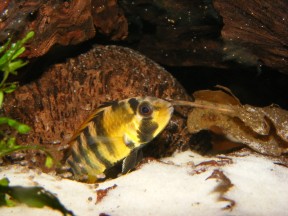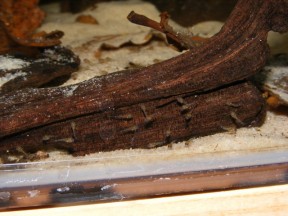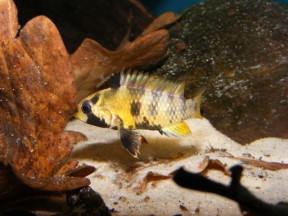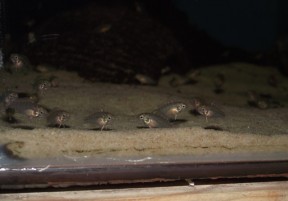Apistogramma baenschi
A188, Inca Dwarf Cichlid, Inka Zwergbuntbarsch (DE)
Etymology
Apistogramma: etymology not explained. Presumably from the Greek ápistos (Gr. άπιστος), meaning ‘unbelieving, doubtful’, and grámma (Gr. γράμμα), meaning ‘that which is drawn or written’, in reference to the variably-developed, often rudimentary, lateral lines in member species.
Classification
Order: Perciformes Family: Cichlidae
Distribution
Type locality is ‘Tributary of Rio Shanushi, lower Rio Huallaga System, Peru, near 6°03’S, 77°53’W’ with additional records from between the towns of Tarapoto and Yurimaguas in the Shanushi and Paranapura drainages, both left-bank tributaries of the Huallaga.
The Huallaga is a major tributary of the Río Marañón in the Amazonian portion of northern Peru.
Habitat
Collected from small, shallow forest tributaries among leaf litter and submerged woody structures.
The water is apparently quite cool, very soft with low conductivity and normally stained the colour of weak tea, and pH has been measured to range between 4.1-6.3.
Sympatric species include an unidentified congener plus Rivulus, Copella, Corydoras and Rineloricaria spp.
Maximum Standard Length
Aquarium SizeTop ↑
Base dimensions of at least 80 ∗ 30 cm or equivalent are required.
Maintenance
Provided adequate cover and structure is available this species is unfussy with regards to décor with ceramic flowerpots, lengths of plastic piping and other artificial materials all useful additions.
A more natural-looking arrangement might consist of a soft, sandy substrate with wood roots and branches placed such a way that plenty of shady spots and caves are formed.
The addition of dried leaf litter provides additional cover and spawning sites, and brings with it the growth of beneficial microbe colonies as decomposition occurs.
These can provide a valuable secondary food source for fry, while the tannins and other chemicals released by the decaying leaves aid in simulation of natural conditions. Alder cones may also be used for the latter purpose.
Fairly dim lighting is recommended and aquatic plant species that can survive under such conditions such as Microsorum, Taxiphyllum or Cryptocoryne spp. may be added, while floating vegetation, especially Ceratopteris spp., is also useful.
There is no need to use peat, the collection of which is both unsustainable and environmentally-destructive.
Filtration need not be too strong, with an air-powered sponge filter or similar adequate.
It goes without saying that these are fishes are sensitive to fluctuating organic wastes and should never be introduced to biologically-immature aquaria.
This species also requires require acidic conditions with negligible carbonate hardness and very low general hardness so a reverse osmosis unit or other method of obtaining soft water may need to be employed, and this can be further acidified using phosphoric acid or similar if necessary.
That said it is less fussy than some congeners and can temporarily withstand moderately hard, neutral water, with aquarium-bred specimens more adaptable still.
Water Conditions
Temperature: 20 – 26 °C
pH: 4.0 – 6.5
Hardness: 18 – 90 ppm
Diet
Apistogramma spp. are chiefly carnivorous and feed mostly on benthic invertebrates in nature.
In the aquarium live and frozen foods such as Artemia, Daphnia, Moina and chironomid larvae (bloodworm) should be offered regularly although most species will also learn to accept dried alternatives with pelleted products generally preferred to flake.
Behaviour and CompatibilityTop ↑
Captive-raised fish are the recommended choice for the community aquarium.
Wild examples are best maintained alone or with small ‘dither’ fishes such as Nannostomus spp., and ideally should not be mixed with other Apistogramma.
It can be maintained in pairs or groups consisting of several males with up to three times as many females in a larger set-up and these will typically form a hierarchy over time.
Both males and females regularly spar for dominance with the latter particularly violent and often involving the locking of lips.
Sexual Dimorphism
Males grow larger than and possess a different colour pattern to females.
The caudal-fin in males has a reddish distal band bordered on both sides by blackish margins while the proximal portion of the fin is greenish yellow.
Males also develop increasingly pronounced, lappet-like extensions to the anterior dorsal-fin rays as they mature, with all rays becoming extended in some older individuals.
The body is bluish violet and the dark vertical bars in the posterior portion are indistinct and relatively thin.
In females the caudal-fin is plain yellowish and the dorsal-fin rays much shorter.
The body is yellowish-grey to yellow with well-defined, relatively broad vertical bars in the posterior portion.
Reproduction
Substrate spawner which normally lays its eggs in crevices or cavities among the décor with a detailed report published by Römer (2006).
Sexually-mature males establish large territories and react aggressively to other males in the vicinity, though the presence of several females is normally tolerated.
Males are normally polygamous but occasionally may form a permanent bond with a single female and form a smaller territory than normal.
Although this species is relatively adaptable in terms of water conditions very soft, acidic water is required in order for the eggs to develop properly.
Post-spawning the male usually returns to protecting his larger territory, leaving the female to guard and tend the eggs and fry.
Depending on temperature the eggs hatch in 36-72 hours with the fry free-swimming after a further 5-6 days, at which point they’re already large enough to accept Artemia nauplii and suchlike.
Sexual maturity is reached in 5-6 months with the proper feeding and care.
NotesTop ↑
This species is assigned the code A188 under the DATZ system and is also known by the trade names A. sp. ‘Inca/Inka’, A. sp. ‘Inka 50’, A. sp. ‘highfin nijsseni’, A. sp. ‘Nijsseni 2’, A. sp. ‘red crescent’ or A. baenschi ‘Inca’.
It’s among those members of the genus produced on a commercial basis, is regularly available in the aquarium trade and perhaps among the most suitable Apistogramma spp. for those new to keeping dwarf cichlids.
Following Römer (2006) it can be told apart from congeners by the following combination of characters: presence of five dark vertical bars in posterior portion of the body in both sexes, more visible in nuptial or aggressive individuals; a distinctive roundish black spot at the caudal-fin base; caudal-fin rounded in shape with small extensions to both upper and lower lobes developing in very large males;
Apistogramma is among the most speciose of South American cichlid genera with around 70 species valid at present but many more awaiting description.
In addition many species exist in two or more geographical colour forms which may or may not turn out to be distinct in the future.
Hobbyists tend to label these with collection data if available in order to avoid mixing them and the potential of hybridisation.
Member species have also been organised into a series of species lineages, complexes and groups by authors in order to better separate them.
Such lists have been augmented by fish that have appeared in the aquarium trade and are in a state of near-constant flux.
For example the A. nijsseni group, of which A. baenschi is a member, is contained within the A. trifasciata sublineage of the larger A. trifasciata lineage alongside A. arua plus the A. brevis, A. cacatuoides, A. atahualpa and A. trifasciata groups.
Apistogramma and a number of related genera are often included in the putative subfamily Geophaginae.
Kullander (1998) conducted a morphology-based phylogenetic study in which the neotropical Cichlidae was divided into six subfamilies of which the Geophaginae contained 16 genera divided among three ‘tribes’:
Acarichthyini – Acarichthys and Guianacara.
Crenicaratini – Biotoecus, Crenicara, Dicrossus and Mazarunia.
Geophagini – Geophagus, Mikrogeophagus, ‘Geophagus‘ brasiliensis group, ‘Geophagus‘ steindachneri group, Gymnogeophagus, Satanoperca, Biotodoma, Apistogramma, Apistogrammoides and Taeniacara.
Later molecular studies by Farias et al. (1999, 2000, 2001) resulted in the additions of Crenicichla and Teleocichla to the Geophaginae, a result supported by López-Fernández et al. (2005) who conducted the most detailed molecular analysis of the grouping to date including 16 of the 18 genera and 30 species.
However their conclusions regarding interrelationships between genera did vary somewhat from previous hypotheses and can be summarised by the following loosely-defined groups:
– a weakly-supported sister group relationship between Acarichthys and Guianacara.
– a well-supported “Satanoperca clade” comprising Satanoperca, Apistogramma, Apistogrammoides and Taeniacara.
– a “big clade” with Geophagus, Mikrogeophagus, ‘Geophagus‘ brasiliensis group, ‘Geophagus‘ steindachneri group, Gymnogeophagus, Biotodoma, Crenicara and Dicrossus.
– a “crenicarine clade” with Biotoecus and Crenicichla.
No representatives of Teleocichla or Mazarunia were included in the study but the former is well-established as sister to Crenicichla while the latter has grouped closely with Dicrossus and Crenicara in earlier works.
The other main conclusions of the paper are confirmation that Geophaginae is a monophyletic group exhibiting strong signs of having undergone rapid adaptive radiation.
References
- Farias, I. P., G. Ortí, I. Sampaio, H. Schneider and A. Meyer, 1999 - Journal of Molecular Evolution 48(6): 703-711
Mitochondrial DNA phylogeny of the family Cichlidae: monophyly and fast molecular evolution of the Neotropical assemblage. - Farias, I. P., G. Ortí, I. Sampaio, H. Schneider and A. Meyer, 2001 - Journal of Molecular Evolution 53(2): 89-103
The cytochrome b gene as a phylogenetic marker: the limits of resolution for analyzing relationships among cichlid fishes. - López-Fernández, H., R. L. Honeycutt, M. L. J. Stiassny and K. O. Winemiller, 2005 - Zoologica Scripta 34(6): 627-651
Morphology, molecules, and character congruence in the phylogeny of South American geophagine cichlids (Perciformes, Labroidei). - Römer, U., 2006 - Mergus Verlag GmbH: 1-1320
Cichlid Atlas: v. 2 - Wise, M., 2011 - World Wide Web electronic publication, http://apisto.sites.no: Accessed on 13.02.17
Apistogramma Species List By Species-Groups/Complexes.







